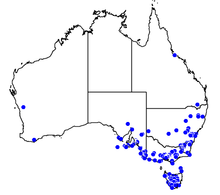Jack Jumper
| Jack jumper ant | |
|---|---|
 |
|
| Worker ant | |
|
Not evaluated (IUCN 3.1)
|
|
| Scientific classification | |
| Kingdom: | Animalia |
| Phylum: | Arthropoda |
| Class: | Insecta |
| Order: | Hymenoptera |
| Family: | Formicidae |
| Subfamily: | Myrmeciinae |
| Tribe: | Myrmeciini |
| Genus: | Myrmecia |
| Species group: | pilosula |
| Species: | M. pilosula |
| Binomial name | |
|
Myrmecia pilosula F. Smith, 1858 |
|
 |
|
| Occurrences of the jack jumper ant reported to the Atlas of Living Australia as of May 2015 | |
| Synonyms | |
|
|
The jack jumper ant (Myrmecia pilosula), commonly known as the hopper ant, jumper ant or jumping jack, is a species of venomous ant native to Australia. Most commonly found in Tasmania and southeast mainland Australia, it is a member of the genus Myrmecia, subfamily Myrmeciinae, and was formally described and named by British entomologist Frederick Smith in 1858. This species is known for the ability to jump long distances. These ants are large; workers and males are approximately the same size: 12 to 14 millimetres (0.47 to 0.55 in) for workers, and 11 to 12 millimetres (0.43 to 0.47 in) for males. The queen measures approximately 14 to 16 millimetres (0.55 to 0.63 in) in length and is similar in appearance to workers, whereas males are identifiable by their perceptibly smaller mandibles.
Jack jumper ants are primarily active during the day and live in open habitats, nesting in bushland, woodland and dry open forests, surrounded by gravel and sandy soil, which can be found in rural areas and are less common in urban areas. They prey on small insects and use their barbless stinger to kill other insects by injecting venom. Other ants and predatory invertebrates prey on the jack jumper. The average worker has a life expectancy of over one year. Workers are gamergates, allowing them to reproduce with drones, whether or not a queen is present in the colony. The ant is a part of the Myrmecia pilosula species complex; this ant and other members of the complex are known to have a single pair of chromosomes.
...
Wikipedia
